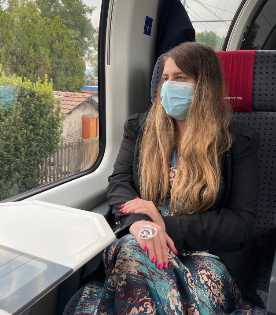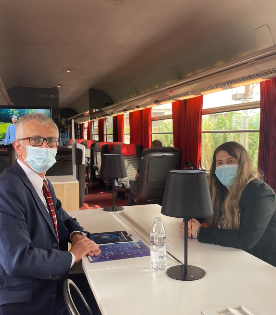Question: Could you describe the experience you had on Connecting Europe Express? What has been the most positive aspect of this initiative?
 Answer:
Answer:
I was really honoured to participate in this very special initiative to promote sustainable mobility on the occasion of the European Year of Rail. I have always loved travelling and I wished I could be onboard the Connecting Europe Express for the whole itinerary across Europe. But I am glad I have been given the opportunity to represent the European Blind Union and be onboard the train on 7 September, on the Italian segment Milan – Genoa – Rome with Mr. Alberto Mazzola (Executive Director of CER – Community of European Railway and Infrastructures Companies). I had a frank and open discussion with Mr. Mazzola about important points to be considered in order to improve the accessibility of rail transport, with the objective of enhancing free movement of persons with disabilities. I think that this was the most important aspect. Indeed, it is essential that DPOs let relevant stakeholders know of the specific needs of persons with disabilities and collaborate with them.
Question: What challenges did you face in this trip (both in general and related to disability)? Did you need any special support?
Answer:
I was told that, although being partially sighted, I would not need a personal assistant, considering that there would be disability assistance at departure and upon arrival and that they would take care of me onboard. Also, I was informed that the limited seats on board the train, as well as the COVID-19 restrictions, had to be considered. I clarified that, although I perfectly understood what they meant, that wasn’t the kind of support I needed. In fact, since my home town is a bit far from both Milan and Rome, there were no trains allowing me to leave on 7 September in the morning to be in Milan in time for the departure of the Connecting Europe Express, or allowing me to go back home from Rome in the evening. I had to go from my home town to Milan on 6 September evening, and had also to stay in Rome the overnight of 7 September, so the support of an assistant would be crucial to me. Every person with a disability has a different specific need that must be met. I must say that the organizers proved to be understanding and, despite the initial difficulty, they agreed for my personal assistant to travel with me.
Question: For young Europeans, the train is a great way to get to know Europe. As a young person with a disability, do you think you have all the information accessible to plan a trip?
 Answer:
Answer:
Accessible information is not always available for young people with disabilities to plan an accessible train trip across Europe. Information is often fragmented and the level of accessibility is not the same in all countries. In any case, information is only a part of accessible travel. The accessibility of trains, stations and relevant facilities must be guaranteed.
Question: In your opinion what should be the future of rail and what do you think the Commission should do to achieve it?
Answer:
First of all, in the future (in the near future I hope), the EU rail system should enable spontaneous and independent rail travel for persons with disabilities. Currently there are still a lot of obstacles to it. Although some achievements have been made through EU Regulation 1300/2014 on the technical specifications for interoperability relating to accessibility of the Union’s rail system for persons with disabilities and persons with reduced mobility (TSI-PRM), and the Trans-European Transport Network (TEN-T), much remains to be done. As stated in the European Parliament resolution of 20 January 2021 on the revision of the Trans-European Transport Network (TEN-T) guidelines, accessibility should be ensured across the EU and its regions. Moreover, the importance is underlined of projects enhancing accessibility, especially for persons with disabilities and older persons.
I believe that a collection of good practices on accessibility -based on the universal design principle- might be a good incentive to enhance its level across Europe, bearing in mind a wide diversity of users.
It may happen that, although the accessibility requirements are formally met, some stations are not actually accessible. Putting in place a quality control system could be a good way to resolve the issue.
Also, the accessibility of infrastructure around train transport should be enhanced: parking stops, pedestrian crossings around the train station may be inaccessible even if the train service itself is accessible.
Appropriate EC funding is instrumental in ensuring the accessibility of rail travel. All stakeholders should collaborate to find appropriate solutions, and DPOs should be always consulted.
Question: Is there anything else you would like to say about Connecting Europe Express experience?
Answer:
I liked the Connecting Europe Express experience very much. It was wonderful to see first-hand that there is a real connection among all railways, a network going across Europe that can help promote European citizenship. It struck me that each train carriage had been made in a different country: I saw this as a symbol of how excellencies from different countries, despite or thanks to the differences, can be put together to create something unique, which is much more than the sum of its parts. It shows what European citizens can do. This can only be done, though, if no one is left behind, and if equal access as well as uniformity of services, i.e. the same (high) level of service quality, are achieved and guaranteed.
Photo credit: Francesca Sbianchi